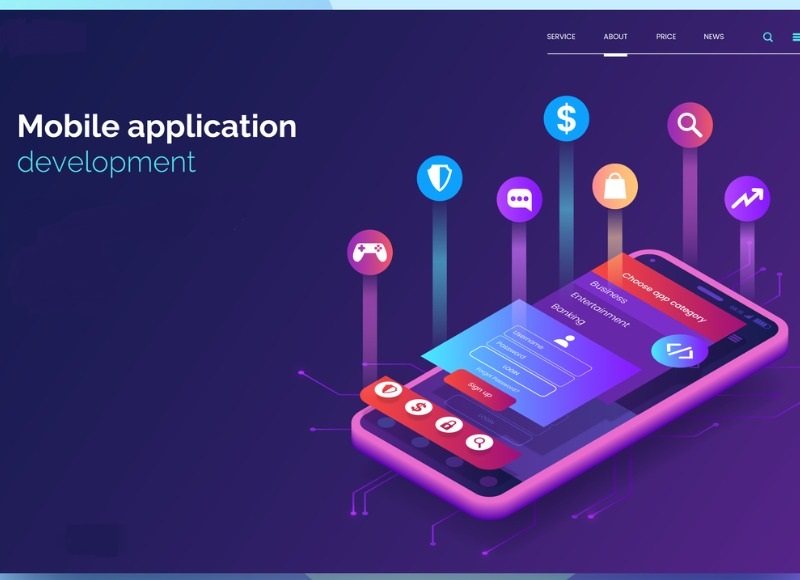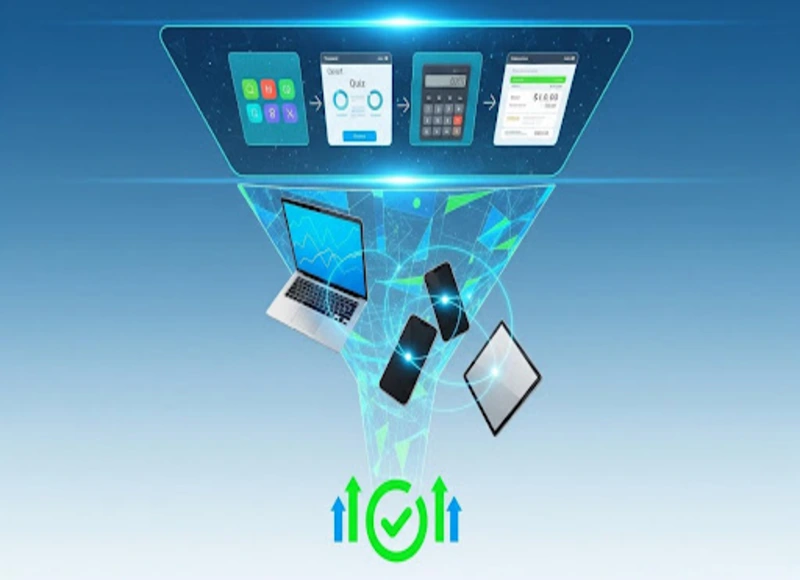Table of Contents
We don't want to scare you by saying that app-making is a long, tedious, and cost-intensive exercise. While all of these may be a bit true, the boost a well-made app gives your business is well worth it.

While hordes of no-code and low-code app builders are available on the market, you may not like to compromise when making the best app for your business. Let's not forget that an app is not always to connect with the customers or the outside world. An app is also used as an internal tool to connect and collaborate with team members, vendors, dealers, and so on.
Whether you're planning to make an app for online sales, CRM, or business process management, the need for a clean layout, robust back-end and the most advanced security protocol are some of the basic goals of the project.
A lot will go into the process to get all these requirements aligned perfectly to give the best possible in your category. No matter how some app-building platform might try to convince you that an app can be made in a few hours and for a few hundred dollars, the truth is that a reliable and enterprise-grade app can't avoid using the best practices and eying to have the most advanced features and solutions. You can't lose sight of the latest technology when making the best apps that can give your competitors some sleepless nights.
We don't want to scare you by saying that app-making is a long, tedious, and cost-intensive exercise. While all of these may be a bit true, the boost a well-made app gives your business is well worth it. It's worth the extra dollars you spend on it.
Now, let's get down to the app-making process and what you should know about it.
How to Create an Application?
How to make an app? Here are some important steps you need to follow to create a high-quality app.
Step1: Pick A Good Name
According to available facts, there are 3.5 million apps in the Google Play Store and 2 million in the Apple App Store.
The mobile app market is huge. So when making an app, you need to consider all the aspects that will help to make your app distinct from the rest and prosperous.
Selecting the right name for your app is among the most crucial strategies for ensuring that your app is not a flop in an app store but attracts a substantial number of users. Be sure your choice of name is unique and easy to remember.
There is no need to decide on the name on your own. Instead, it would help if you did a little research with relatives and friends to choose words that appeal to people. In addition, big companies can take a research firm's help to get market insight on the matter.
Connecting the app's name to its main features is generally recommended. Still, there is no fixed set of guidelines. So it's important to consider all the possibilities.
This is easier if there is already a brand name or website. But if you're beginning, it is also essential to focus on the overall branding of your app. This is because the branding directly impacts the app's marketing strategies as well as the overall success of the app.
Here are a few general guidelines to be aware of when naming the app:
- The name must be tied to the general brand.
- Be sure that the app's name is distinctive and easy to say.
- Choose a name that is appropriate to your intended audience.
- Make sure you choose an option that has worldwide appeal.
Step 2: Finalize Functionalities
Making sure you know all the functionalities you want in your app is among the most important steps in creating an app.
You've probably considered various features and ideas you'd like to integrate into the app. In addition, you would have already established the app's overall goal. So why do you want an app in the first place?
Therefore, you must make a final sketch of the functionalities of your app in line with the goals you've set.
The first step is to identify and define the essential features of your app which will distinguish it from other platforms. Next, note all the functions and features you wish to include within your application.
Consider the results of extensive consumer research and user feedback in this phase. Innovative features such as live tracking, integration with payment gateways, face identification, security protocol, registration module, and many other parts are more prevalent in applications.
After you've jotted down all features you want, removing the ones not needed from your checklist is next. Adding unnecessary features in the app's final version won't be useful. It will instead negatively affect the performance of the app.
If you've got an established idea for your app, then you can begin the process of developing your app to the highest efficiency and be sure of the app's success. Making the right marketing strategies to create an app that solves specific problems with specific functionalities is simpler, allowing it to be easily accessed by the users.
Step 3: Create Wireframe and App Mockup
Many people mistakenly believe that creating wireframes is a difficult job. However, it is, in reality, an outline of the mobile application.
Utilizing complex tools and app development softwares to design the app isn't necessary. Instead, making a wireframe using paper or a simple online wireframe tool is possible.
There are numerous methods to build wireframes. This process aims to demonstrate the features and design of the mobile app. If you're doing app building for an iPhone app as well as an Android app on your own, it is possible to create multiple wireframes.
Be aware that the primary goal of the wireframe must be on the flow and structure of the app. If you can get the final appearance of your app, then that's awesome, but it's not the main objective of the design. A well-designed wireframe will address the user's journey in general and the notifications and screen pop-ups that can happen when you click the button.
Find alternatives to what could occur when the user presses different buttons. For example, wireframes are important when multiple people work on an application. It helps define the app's vision and lets everyone get on the same page regarding the organization and operation of the application.
The layout is the most important thing to establish before working on your app's interface. It is here so that your imagination gets a real shape. All the thoughts you've held in your head are destined to be included in the application. This is a crucial component of the entire application. You don't want to ruin anything you've planned because what is created at this point will be long-lasting.
The first thing to pay attention to is the wireframe. This black-and-white design is intended to be a sketch. Therefore, ensuring that all features are aligned and planned for an initial mockup is important.
Every mockup aims to create something that looks realistic but also static. Therefore, you don't need to put more effort into it. However, you want to know how your app will appear to users. It's possible to incorporate images and icons, logos, and anything that will give it a realistic look without making the application functional.
Step 4: Create App Design
There are a variety of things to consider in an effective app design about the overall style and user interface. This is more than choosing the appropriate color scheme. Instead, your primary focus should be on developing an app that is user-friendly and distinctive and attracts and appeals to prospective users.
A no-code app creator, like Codev, enables users to build functional apps for iOS and Android without needing in-depth knowledge of app development. However, using an app developer will ensure that you get your app on time and that it matches the quality parameters, features, and functionalities you've set.
It is crucial to experiment with different styles and designs to improve the aesthetics of your app. Concentrate on the following elements of the app one at a time.
App Icon and Splash Screen
Your app's icon represents the primary thing potential customers will see when interacting with your application. Therefore, it is crucial to create an attractive icon to ensure that users click it on Google Play or iOS App Store.
If you have a logo for your business that you like, you can make it available as your app's icon because it can aid in establishing brand recognition. If not, you can design logos with easy-to-use graphic design tools like Canva.
Additionally, you must select an appropriate background that will increase visibility. Most of the time, selecting an easy block color for your background is sufficient, as you'll be putting your logo on top of the company or application. Ensure your design doesn't look crowded because it can negatively impact users' experience.
The splash screen of an app appears as a screen. It is displayed after you click on an app. This is the first step in introducing users to your app. So it would help if you designed a compelling splash screen to encourage users to use the app. Design attractive images for your splash screen and integrate them into your application.
App Layout
The app layout is the overall layout and structure of an app. It is the way that parts and functionality of an app are organized. In addition to the app's aesthetics and good web design for your business, you must also concentrate on ensuring that the interface is user-friendly.
A user-friendly interface will leave an excellent impression on users. So, in reality, UI/UX design is one of the most critical aspects of developing mobile apps.
It is possible to use the vast collection of themes that do not require coding to modify the layouts to suit your preferences and needs.
Fonts and Colors
When creating mobile applications, your primary concern is to ensure that your app is accessible to all. This includes using appropriate colors and fonts that everyone can comprehend and read.
It is possible to use various fonts for your header, text, and footer. However, be careful not to use too imaginative or cursive fonts because they can make your app less readable and cause users to abandon your application.
At this point, you should be able to see the overall layout of your app. It would help if you began placing the text and other alternatives strategically. Instead of thinking as the developer, play the role of your potential customer and determine if you can use the application.
Step 5: Build an MVP
Always create an MVP, a minimum viable app in this case, before you start developing your software. The main advantage of an MVP is that it brings the focus to the most important features of your app.
This is an essential aspect of an app development project. What are the essential features needed for your app to function? Start with those features and then move your focus to other features.
Building an app can be messy, and you may get distracted and lose sight of your goal. Eventually, it will cause delays and additional costs. Even the basic functionality of your program might be affected by stray ideas during an app development project.
It is always possible, especially with an adroid and iOS app builder that does not require coding. Ensure the MVP has the capabilities needed to meet the most fundamental functions and usage scenarios.
Please do not be concerned about the quality of the MVP since it's not important at this point. However, even though MVP isn't a full application, it's much more than a test application.
Step 6: Build the App
It's time to finish designing your application. The first step is to create the pages that will serve as the display screens in the application.
Once you've decided on the design of your screen, it's time to create the procedure that will assign your app's navigation.To do this, we recommend keeping your content natural and simple. Avoid using flashy content that takes the focus away from the main content.
This is an important process when creating an application. After you've finished the responsive web design of the app, you'll need to identify the content that will be used.
The development process that does not require basic coding is the most effective option for developing an app since it's less work and often more affordable.
4 Mobile App Development Best Practices To Follow
Choose the development approach that best suits your needs based on your extensive study. You might have discovered that there is a difference in the way mobile applications are developed. It is possible to build native, cross-platform, and web-based applications for mobile devices.
In making your choice, you'll need to consider your resources and the characteristics of your mobile application.Choose the one that is a good match to the programming language you are familiar with. Native apps are great for providing a great user experience (UX). However, they are more expensive because you'll need to build just one platform.
Web-based apps, on the contrary, are great as they allow mobile views with no restrictions on the app store. In addition, cross-platform applications can be a great option if you're trying to reach the largest number of users on a lower budget.
1. Conduct an in-depth study
Conducting extensive study is among the best mobile app development methods you shouldn't allow to slip through the cracks.
- Do not forget about financial considerations. First, study the recent net and gross income trends and determine the earnings. That would determine the necessity of a mobile application. Then, examine the complicated cost structure.
- Find your customers and understand the needs of your customers. Doing this lets you know the potential channels for acquiring customers to choose from. In addition, you'll estimate the number of active users and downloads of your app following its launch.
- Be aware of the obstacles in your way. Find your competition in your niche. You must be able to select rivals to compare their objectives within the market. Look at companies that are starting up or even top-performing firms. Find their strengths and weaknesses and then incorporate them into your plans to develop an app.
Launching your company and investing in the apps in development requires you to think beyond just the potential results of the project. Therefore, it is essential to monitor all the details to ensure you understand the issues you might face.
2. Consider security to be of the utmost importance
Making a mobile app also implies ensuring the user and sensitive information. The kind of data you collect will depend on the capabilities of your app. However, you are responsible for handling each data item with the highest security.
When you begin the development process, it's essential to read about mobile application development best practices to secure your data and safeguard your users and your business.
Be sure to write a secure program encrypted for every data stream, using only the official API and employing high-level security authentication. These are the most efficient ways to ensure your mobile application is calm.
3. Create a solid core
In the initial planning phase, ensure you've built a strong foundation. The essential functions are the primary component of your app since they are the foundation on which all additional features will be based.
Note the most important aspects of your application in an inventory based on the value of each function. It is possible to use plugins in the later stages of development. But first, create your plugin with distinct features you can use whenever the program needs to.
This will make it easier to manage the entire mobile development process for apps, particularly when it comes to apps that use longer programming codes.
4. Receive feedback and make the needed improvements
Happy users will stick with you, while unhappy users will ultimately seek alternatives. Therefore, getting feedback from users and using them as a measure to make the next modifications to your app is essential when developing mobile apps.
Please take note of the feedback from your users, not only on the performance of your app following its deployment but to discover other issues.
Make sure there's a simple and easy means for your users to rate your app via social media, email, or your application.
Important Features You Can Add to Your App
Once you're familiar with the basic steps of creating an app, let's look at the most crucial and well-known features of a reliable mobile application.
At this point, you're able to start developing an app. However, competition is increasing in the field of mobile app development. So, you must consider including special features that draw people in and create faithful app customers. How you make an app your customers want to use is a good question to ask for.
It is essential to incorporate the relevant features into your app. Features are essential to ensure that you provide the highest level of customer service.
Of course, it's contingent on the goal of the app you're creating. However, there are some common features that users of all kinds of apps enjoy. Some of the most sought-after features that most apps have include:
Blog
A blog is an excellent way to share your thoughts and ideas, and you can start many kinds of blogs. It is the best platform to share your knowledge with thousands of people seeking it.
You can also convert your WordPress for business websites into an application and allow your readers to quickly access all the relevant information you provide.
The most significant benefit of this approach is that you free the space on their precious devices, increasing the chance they will continue using your application.
Latest Events
Everything needs to be planned, from a wild college party to an enormous business event. Even the tiniest details could result in everything falling to pieces.
It is only natural that an event planner trusts a reliable source, such as an app with a great Event function. Using this feature to plan your trip and eliminate the chance of errors accurately is possible.
When you combine this feature with Calendar or Push Notifications, you will be able to ensure that everyone who uses your application is aware of any new updates or information.This feature can also notify users on holidays or international days. It's a typical method used by people who use mobile devices.
They usually ignore an app after installing it. However, if you send notifications at a reasonable frequency, they could continue using your app for a lengthy period.
In conclusion
We know how huge a task it is to create your apps. It cannot be easy, even when created using a no-code platform. So make sure you have a list of tasks to follow a defined method.
Following the steps mentioned in the previous paragraphs, you'll be in a good position to develop a successful mobile application. It allows you to fulfill your development needs quickly and get the desired results in little time.
Recent Blogs
Key Benefits of Hiring Nearshore React.js Development Teams for Enterprise Projects
-
20 Jan 2026
-
10 Min
-
120
Stop Building from Scratch: Boost Your Marketing Funnel with App Templates
-
13 Jan 2026
-
10 Min
-
466







